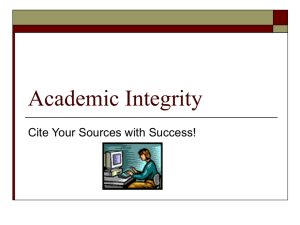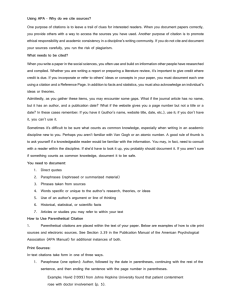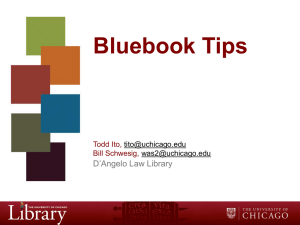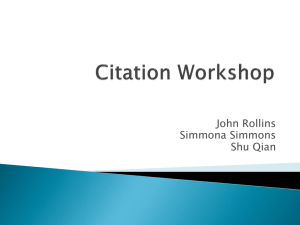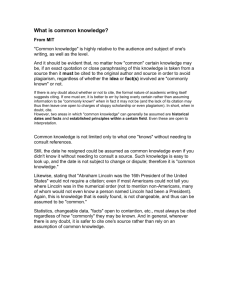Bluebook
advertisement
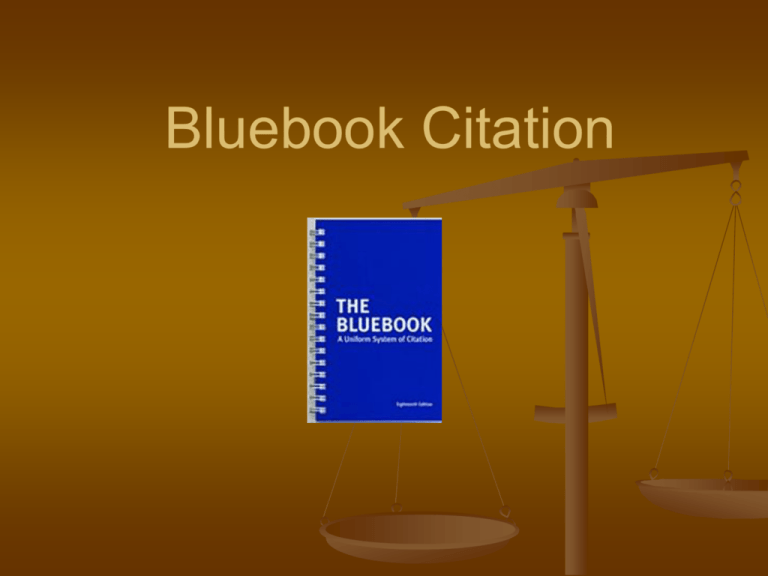
Bluebook Citation What is the Bluebook? The Bluebook: A Uniform System of Citation, 19th ed. Compiled by the editors of the Columbia Law Review, the Harvard Law Review, the University of Pennsylvania Law Review, and The Yale Law Journal. Other Legal Citation Formats ALWD Citation Manual (pronounced all-wood or owl-wood) Green Book (Texas) California Style Manual APA MLA Bluebook citation format is most frequently used Purpose of Citation Identify the document and document part to which the writer is referring Provide the reader with sufficient information to find the document or document part Furnish important additional to assist readers in deciding whether or not to pursue the reference Importance of Citations Judges care about citations and how briefs are drafted. "Plaintiffs’ . . . complaint . . . could have been drafted in crayon on the back of a napkin.” Castro v. City of Chicago,1998 WL 801814, at *2 (N.D.Ill. Nov. 13, 1998). Bluebook Introduction For generations, law students, lawyers, scholars, judges, and other legal professionals have relied on The Bluebook’s unique system of citation in their writing. What is a citation? Black’s Law Dictionary defines “citation” as: A reference to a legal precedent or authority, such as a case, statute, or treatise, that either substantiates or contradicts a given position Often shortened to cite Types of Legal Sources Primary Sources: Constitutions Cases Statutes Regulations Secondary Sources: Books/Treatises Encyclopedias Dictionaries ALR’s Legal Encyclopedias Practice Guides Periodicals (law review/bar journal articles) Newspapers/Magazines Internet Sources Constitutions See Bluebook Rule 11 1.The state (or country) abbreviation; 2.The abbreviation for "Constitution"; and 3.The section or subdivision you are citing. Examples: U.S. Const. art. 1, § 8 Minn. Const. art. I, § 13 Statutes Statutes – enacted by legislature (Congress or state legislature) Regulations – enacted by administrative agencies Codes – a systematic collection or revision of laws, rules, or regulations “Code” can refer to statutes or regulations Federal Statutes: compiled in the United States Code “U.S.C.” or “U.S. Code” Federal Regulations: compiled in the Code of Federal Regulations “CFR” Federal Statutes 1.The title number; 2.The code's abbreviation; 3.The section number of the statute; and 4.The year on the spine of the code volume (not the year the statute became effective) Example: 17 U.S.C. § 1201 (2006) Federal Statutes Year of the code Example: 17 U.S.C. § 1201 (2006) Volume number Section number Note: Many judges and practitioners now delete the “Year of the Code” Example: 17 U.S.C. § 1201 USCA and USCS Where possible, cite the official code and not unofficial codes Unofficial versions of the U.S. Code from commercial publishers United States Code Annotated (West) 17 U.S.C.A. § 1201 (West 2000) United States Code Service (LexisNexis) 17 U.S.C.S. § 1201 (LexisNexis 2004) State Statutes Varies by state Minnesota: Minn. Stat. § 609.185 (2010) Wisconsin: Wis. Stat. § 134.98 (2010) Utah: Utah Code section 30–3–10.4 (2008) Utah Code Ann. § 57–3–103 (Supp.2010) Cases: Background A court opinion is the court’s written statement explaining its decision in a “case” or “opinion” often written by an appellate court. Judicial opinions are printed in bound law reporters or reporters. Law Reporter A law reporter (or “law report”) is a published volume of judicial decisions by a particular court or group of courts. Law reports may be either official (published by the government) or unofficial (published by a private publisher). Components of a Citation Brown v. Helvering, 291 U.S. 193 (1934) Volume Number Page Number Names of the Parties Name of the Reporter Year of the Decision U.S. Supreme Court Cases The opinions of the U.S. Supreme Court are published officially in a set of case books called the United States Reports. In the citation Morgan v. United States, 304 U.S. 1 (1938), “304 U.S. 1” is the abbreviation from the U.S. Reports. Commercial Publishers Supreme Court cases also appear in: The Supreme Court Reporter (S.Ct.) published by Thomson-West and; The United States Supreme Court Reports, Lawyers' Edition 2d (L.Ed.) published by Lexis Supreme Court Reporter (S.Ct.) United States Supreme Court Reports, Lawyers' Edition (L.Ed., L.Ed.2d) What is a parallel citation? Reference to a case that has been reported in more than one reporter. Bluebook citation reads: Morgan v. United States, 304 U.S. 1 (1938) The same reference including parallel citations reads: Morgan v. United States, 304 U.S. 1, 58 S.Ct. 773, 82 L.Ed. 1129 (1938) The main citation is to the U.S. Reports (U.S.) and the parallel citations are to the Supreme Court Reporter (S.Ct.) and to the Lawyer's Edition (L.Ed.) What is the Federal Reporter? The Federal Reporter (“F.2d” or “F.3d”) is case law reporter containing opinions from the U.S. courts of appeals and the court of Federal Claims. Example: Mejdrech v. MetCoil Systems Corp., 319 F.3d 910 (7th Cir. 2003) What is the Federal Supplement? The Federal Supplement Reporter (“F.Supp.” or “F.Supp.2d”) is case law reporter containing select opinions from U.S. District Courts. Example: Potts v. Dyncorp Intern. LLC, 465 F.Supp.2d 1245 (M.D.Ala. 2006) State Cases: Regional Reporters State cases are published in regional reporters. West's National Reporter System is a set of reporters that divides the 50 states and the District of Columbia into seven regions: South Western Reporter (S.W.2d, S.W.3d) Atlantic Reporter (A.2d) North Eastern Reporter (N.E.2d) North Western Reporter (N.W.2d) Pacific Reporter (P.2d, P.3d) South Eastern Reporter (S.E.2d) Southern Reporter (So.2d) Map of Regional Reporters Minnesota State Cases Minnesota Supreme Court: Minnegasco, Inc. v. County of Carver, 447 N.W.2d 878 (Minn. 1989) Minnesota Court of Appeals: Great W. Cas. Co. v. Christenson, 450 N.W.2d 153 (Minn. Ct. App. 1990) Minnesota State Capitol Wisconsin State Cases Wisconsin Supreme Court: Aicher v. Wis. Patients Comp., 613 N.W.2d 849, 865 (Wis. 2000) Wisconsin Court of Appeals: Sudgen v. Bock, 641 N.W.2d 693 (Wis. Ct. App. 2002) Wisconsin Supreme Court Use lowercase “v.” Use the lowercase “v.” in case citation Correct: Smith v. Jones Incorrect: Smith vs. Jones Incorrect: Smith V. Jones Party Names Do not include first names of parties, unless they are the name of a corporation: Cite as: Smith v. Jones Do not cite as: John Smith v. Paul Jones Cite as: Baker v. John Smith Inc. Party Names If there is more than one plaintiff or defendant, use only the first party on each side. Correct: Bush v. Gore Incorrect: George W. Bush and Richard Cheney, Petitioners v. Albert Gore, Jr., et al. Case Names Use italics (not underlines) Correct: Bush v. Gore Incorrect: Bush vs. Gore Incorrect: Bush v. Gore Dates Generally, include only the year of the decision. Example (reported case): Bush v. Gore, 531 U.S. 98 (2000) If the case is unpublished, include the month, day, and year. Example (unreported case): Castro v. City of Chicago,1998 WL 801814 (N.D.Ill. Nov. 13, 1998). United States Use “United States” when the United States is a party Do not use “U.S.” or “United States of America” “United States” is never abbreviated when the United States is a party in a case name. However, it may be abbreviated as part of another party’s name, like any other word in T.11. In textual sentences, “U.S.” may be used as an adjective, but it should never be used as a noun. Example: United States v. Church of Scientology W. U.S., 973 F.2d 715 (9th Cir. 1992). Short Cite: Consecutive Citations Give the long cite when a case is first cited in a document. On references to the same case immediately following that case (or “consecutive citations”) use the short cite format with “Id.” Full cite: McDonald v. Eubanks, 731 S.W.2d 769, 770 (Ark. 1987). Short cite still citing page 770: Id. Short cite now citing page 771: Id. at 771. Using “Id.” If the same citation immediately follows the previous cite (consecutive citations), use “Id.” If the same citation immediately follows the previous cite (consecutive citations) but on a different page, use “Id. at [page number]” Example (same page): Id. Example (page 97): Id. at 97. Short Cite: Non-consecutive Citations If the long cite has been previously given but the cite does not immediately follow the cite (e.g. new cites are given), use the short cite format for nonconsecutive citations. Long Cite (first reference in document): “The Fourth Amendment protects people, not places.” Katz v. United States, 375 U.S. 76, 82 (1965). Short Cite (non-consecutive citation): “The Fourth Amendment protects people, not places.” Katz, 375 U.S. at 82. What is a pinpoint citation? A pinpoint citation is the page on which a quotation or relevant passage appears, as opposed to the page on which a case or article begins. For example, the number 217 refers to the page number in the pinpoint citation for Baker v. Carr, 369 U.S. 186, 217 (1962) Also called jump cite; pincite McConnell v. Federal Election Commission, 540 U.S. 93 (2003) is a U.S. Supreme Court case 300 pages in length. Imagine trying to find a quote in a 300 page case without a pinpoint cite. Aaaargh! Pincite More examples: Long cite: “The Fourth Amendment protects people, not places.” Katz v. United States, 375 U.S. 76, 82 (1965). Short cite (consecutive): “The Fourth Amendment protects people, not places.” Id. at 82. Short cite (non-consecutive): “The Fourth Amendment protects people, not places.” Katz v. United States, 375 U.S. at 82. The first page of the opinion is on page 76 and the page where the quotation appears is on page 82. More Examples: Cases U.S. Court of Appeals for the Seventh Circuit: Kennedy v. Nat'l Juvenile Det. Ass'n, 187 F.3d 690 (7th Cir. 1999) U.S. District Court, District of Minnesota: Haghighi v. Russian-American Broad. Co., 945 F. Supp. 1233 (D. Minn. 1996) U.S. District Court in Minneapolis Unpublished Cases Cases published in law reporters are “reported” or “published” cases. Unpublished cases may also appear on court websites or Westlaw and Lexis, the leading online legal research services. Courts may have local rules that prohibit attorneys from citing unpublished cases. Abbreviations Be sure to use proper abbreviations in the Bluebook Case names (Table T6) Example: Association = Assn. Court names in citing cases (Table T7) Example: Probate Court = Prob. Ct. Geographical terms in citing cases (Table T10) Example: Minnesota = Minn. Periodicals (Table T13) Example: Wall Street Journal = Wall St. J. More Abbreviations in Case Names Check Table 6 for common abbreviations in case names Association = Ass’n Committee = Comm. Corporation = Corp. University = Univ. Example: Jones v. Univ. of Minn. Law Review Articles 1.The authors' name full as it appears in the article; 2.The title of the article or headline (italicized); 3.Volume number of the law review; 4.The abbreviated name of the law review; 5.The page number of the article's first page; and 6.The law review's year of publication. Example: Dan L. Burk & Julie E. Cohen, Fair Use Infrastructure for Rights Management Systems, 15 Harv. J.L. & Tech. 41 (2001) Other Secondary Sources Legal Encyclopedia: 2 Am. Jur. 2d Administrative Law § 416 American Law Report (ALR) Annotation: Mitchell J. Waldman, When Will Federal Court of Appeals Review Issue Raised by Party for First Time on Appeal Where Legal Developments After Trial Affect Issue, 76 A.L.R. Fed. 522 (1986) Newspaper Articles Include author, title, name of publication, date, and page Example: Steven Greenhouse, Democrats Drop Key Part of Bill to Assist Unions, N.Y. Times, July 17, 2009, at A1 Internet Resources Follow Rule 18.2.2 when citing material online sources Where possible, cite the printed source Provide: 1) Author's name; 2) Title; 3) Date of publication; and 4) URL Do not simply provide the URL Example: Emily Bazelon, In Defense of the New Judicial Activists, Slate (Aug. 9, 2010), http://www.slate.com/id/2263347/. When in Doubt? See how the source is cited in a recent law review article or recent case from the U.S. Supreme Court or state supreme court Used by legal practitioners Think of purposes of citation: Direct reader to a particular source Adds credibility to legal arguments Direct and persuasive authority Web Resources http://www.law.cornell.edu/citation/ Introduction to Legal Citation; Lots of Examples http://www.legalbluebook.com/ Official Bluebook Site (online subscription available and FAQs) http://www.ll.georgetown.edu/guides/bluebook1_7.cfm Georgetown Law Library

